Updated: 23-May-2019
(see AiResearch, see Allied Signal, see Honeywell). Currently Garrett is part of the Honeywell group, and has gone through the mentioned companies.
-In his origins as Garrett, it started with auxiliary ground and on-board power groups, APU and APP.

“Garrett logo”
-Hacia 1945 aparecieron de tipo maleta, con turbina, el 43 y el 44 (otra vez ver AiResearch)
Towards 1945 these power groups appeared as suitcase type, with turbine. These were the 43 and 44 models (again see AiResearch)
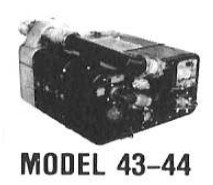
-At mid-1948, it was model 70.
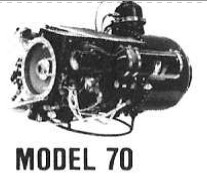
-In 1950 there was model 85, wich was improved in 1955 with version "4 brg" (4 bearings).
-Between 1957 and 1958, Model 30 appears, and immediately, it was the first power group destined to be soon a highly successful turboprop, the 331, which will be discussed more extensively further on in this chapter.
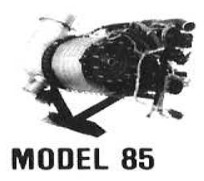

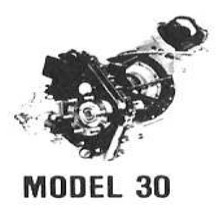

-Model 85 with 2 bearings came out between 1962 and 1963.
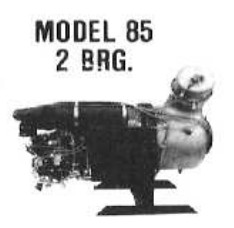
-Before 1965, model 36 came out, and soon after that, the 105.
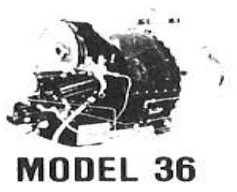
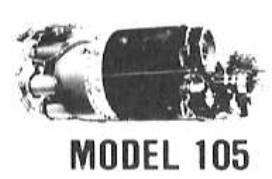
-At that moment the model of auxiliary turbine 331 gets the necessary accessories for the propulsion of airplanes; a propeller is attached to it, and it becomes the TPE-331 turboprop.
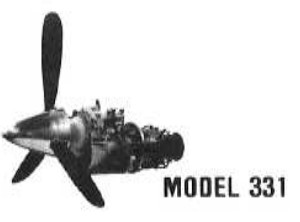
-It was followed by the Models 831-500, 165, 660, 700 and 36-50 / 100.
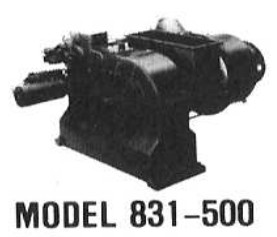
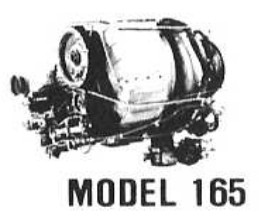
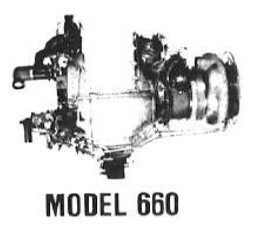

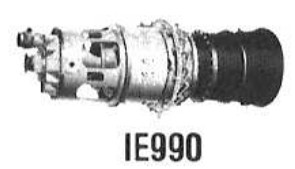
-Almost in 1980, the ATF-3 is tested with low infrared "signature", therafter the 1042, 131, 341, and 351 came out.

-The TPE-331 has been built for more than 40 years, derived from the 331 group, and has been installed in innumerable brands of medium aircraft.
-For this, it has a facility to adapt its gearbox and front air intake, which can be fitted above the motor shaft or below it.
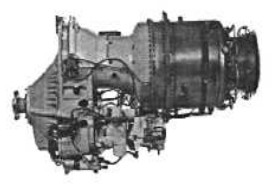
“Lower intake version”

“Higher intake version”
-The shaft for the turbines and compressors is the same and unique going through the gearbox directly to the propeller.
-Therefore the start-up process takes more time that in free gas generator motors and also uses more electrical consumption, being convenient the aid of an external power group if the onboard batteries are not rather "whole".
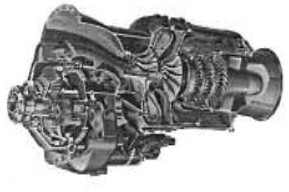
“Cutaway with lower gearbox”
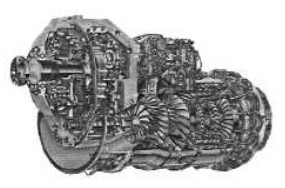
“Cutaway with higher gearbox”
-The gearbox has first, the shaft pinion and a large crown wheel, and then another reduction stage with planetary gear.
-The TPE-331 has two centrifugal single-side compressors, staggered. It has a annular combustion chamber with inverted flow, and a three-stage turbine for better use of the energy from the gases.
-All shown engines have pull propellers. Very little known and rare is the push propeller version. The power output is from the rear behind the turbine that follows with three stages. It is the TPE-331-16 version.
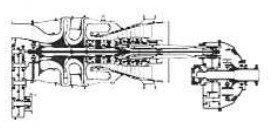
“TPE-331-16”
-The two-stage centrifugal compressor is driven by the two turbine stages, the next stage is the one that drives the propeller.
-In this case, because it is an engine with a free turbine gas generator (which does not drive the propeller), starting the engine is easier and faster and requires less consumption of electric start-up.
-Push propellers, rarely require an anti-icing or thawing system. Since the exhaust gases flow through the rotating blades, they hardly accumulate ice.

“T-76”
-The military version of the TPE-331 is the T-76.
-Powers are between 750 SHP up to more than 1400 SHP, depending on the model.
-They consume less fuel than their competitors, but they are noisier and more delicate than their congeners PT-6, Astazou, Bastan or Walter 601.
-Ha existido el TFE-76, turbofan de un sólo eje, basado en el “core” del T-76 (TPE-331) y para 1500 lbs. de empuje. La designación USAF fue la de F-109-GA-100.
There has been the TFE-76, a single-shaft turbofan, based on the "core" of the T-76 (TPE-331) and delivering 1,500 lbs. of thrust. The USAF designation was F-109-GA-100.

“F-109”
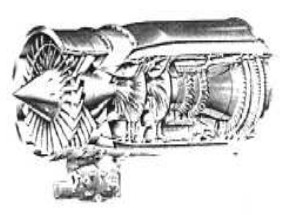
“F-109 cutaway”
-The TSE-76 turboshaft version was derived from the TPE-331 (-3) turboprop that delivered 700 hp.
-This is seen in the re-equipment of the Sikorsky S-55T.
-The next important Garrett engine is the TFE-731, a turbofan that started with 3,500 lbs of thrust. It had two shafts and reduction gear for the fan.
-It is widely used in general aviation for Lear Jet, Falcon, and other civil aircraft. It was also used in some military training aircraft like CASA 101.
-And there was the rare and little known TFE-531, perhaps previous to the famous TFE-731.
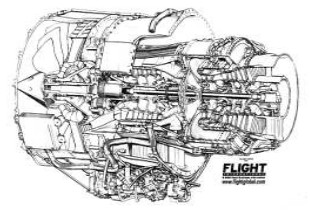
“TFE-531, also from Flight”
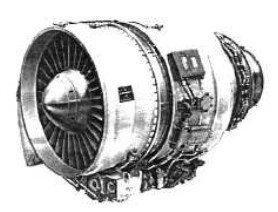
“TFE-731”
-It is a mixed axial-centrifugal compressor driven by a simple one-stage turbine.
-The fan, with planetary gear reduction is driven by a three-stage turbine.
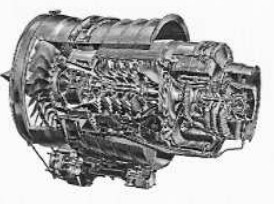
“TFE-731 cutaway”
-The TFE-731-5A engine has a silent exhaust system consisting of a rosette that divides the flow, passing it to other higher, not-audible frequencies.
-Curiously, with this device the power increased 200 lbs. with respect to the TFE-731-5. Although increasing in weight as well.
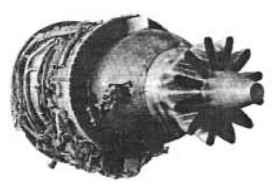
“TFE-731-5A”
-A derivative of this engine is the TFE-1042, developed in collaboration with Volvo Flygmotor (see Svenska Flygmotor and Flygmotor).
-In the beginning it was known as TFE-731 model 1042.
-The core and the accessories are similar, and the initial thrust as well, 3,630 lbf. for the -5, progressively increasing to 4,150 lbf. dry and 6,800 lbf. with afterburning for the -7.
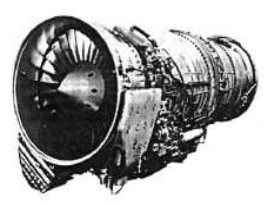
“TFE-1042”
-Conocido como T-124-GA-100 (TFE-124 ó TFE-1042-70 en el caso de la versión para la aviación militar de la China Nacionalista -ver ITEC-), con postquemador.
They were known as T-124-GA-100 (TFE-124 or TFE-1042-70 in the case of the military aviation version of Nationalist China -see ITEC-), with afterburner.
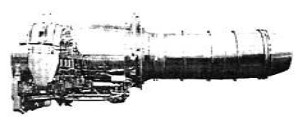
“TFE-124”
-The TFE-1088 version (F-124-GA-101) is similar to the 1042 and it is a "matured" product of it.

“TFE-1042”
-These engines, in turn, are derived from the TFE-731. With powers between 5,000 lbf. dry and up to 14,000 with afterburner, according to their version.
-Garrett has also built engines for RPV's, target drones, etc.
-The best known is perhaps the ETJ-131, model 1030, an expendable turbojet (ETJ) with 100 lbf or initial thrust, increasing to 200 lbf by a simple form of afterburning.
-It had one shaft with centrifugal compressor and centripetal turbine.
-It was a very basic design with an inverted and tubular combustion chamber.
-Continuing with this brand's engines, the next engine of interest could be the ATF-3 (F-104-GA-100), a curious turbofan engine with a unique gas generator.

“ATF-3, schematics”
-First, an axial compressor directs the air towards the "tail" of the engine through a channel created between two "ducts", turning again to meet with another centrifugal compressor driven by a single turbine.

“ATF-3, cutaway”
-As a three-shaft turbofan, this centrifugal compressor and its single turbine is considered its gas generator.
-The accessories are driven by this part of the engine, very simply being coupled to this rear part of the engine.
-The axial compressor is driven by another shaft and by the two-stage turbine.
-Finally, the fan is driven by a new three-stage turbine. This is the fan that really provides most of the power of the engine.
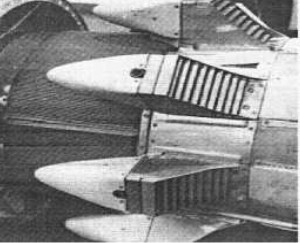
“ATF-3 exhausts”
-The exhaust gases come to another 180° turn and enter the fan's "By-pass" channel.
-As these outputs are hidden, infrared emissions can not be seen from the outside, not leaving the "signature" for possible aggressor missiles. It also had a low sound level.

“ATF-3”
-The ATF-3's initial design delivered around 5,000 lbf of thrust in the 1970's.
-The ATF-3 in the cutaway drawing as it appears in the English aeronautical Flight magazine is shown below. With the intention to have a better way to clarify its architecture, which is very original.
-This is tried to describe as much in the chapter Garrett as in the one of AiResearch, Allied Signal and Honeywell, where this engine has been treated.

“Garrett/Allied Signal, now Honeywell, ATF-3”
-The TPF-351 turboprop engine is the brand's first of its kind with a free turbine.
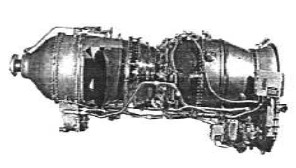
"TPF-351"
-With the philosophy of a push propeller engine, the "rear" air intake, in this case, becomes front. (TPF-351-20).

“TPF-351 installation drawing”
-In part, they take the example of the PWC PT-6 outlay. The double compressor is driven by a two-stage turbine, while the propeller is driven by a three-stage turbine through reducing gear. The power is about 1,500 SHP.
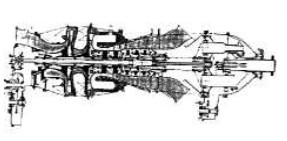
“TPF-351 cross-section”
-Garrett has collaborated with other companies such as GE to develop the CFE-738 in which GE provides the "core" and engine controls while Garrett developed the LP system, that is, the Fan and the low-pressure turbines, as well as associated elements.
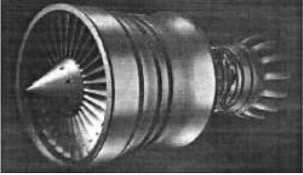
“CFE-738”

“CFE-738 cross-section”
-With Allison, they developed the T-800 engine for the LHX helicopter program.

“T-800”
-Garrett comes from AirResearch, then both were integrated into Allied Signal and today they are in Honeywell.
-We obtained a cutaway view for the T-800.
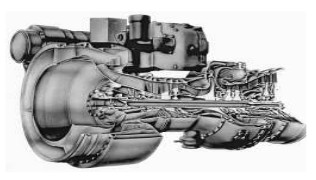
“Garrett T-800”
-We have also received a new image of the TFE-731, a Fan turbojet engine of considerable success both civilian and military.
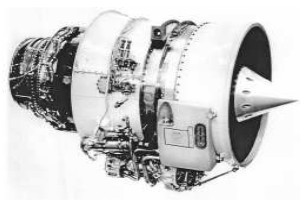
“Garrett T-731”
-The TFE-731 engines are between 3,230 and 4,500 pounds of thrust. Construction began at the Garrett Turbine Engine Company in Phoenix, Arizona.
-Next another turbine, an air-turbine that corresponds to an air-starter.
-It was presented at the 1986 Farnborough Air Show. By that time, it was already said that more than 11,000 units had been built.
-They have been mounted on airplanes such as the B1-B bomber, the C-5B transport and the F-18 fighter. In commercial aircraft, it has been seen on the Boeing B-737, 747 and 767, on the Airbus A-300, A-310 or A-320. In the McDonnell-Douglas DC-10 and MD-80.
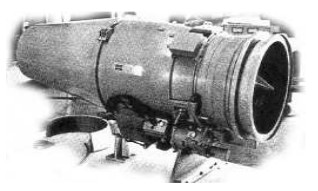
“Garrett TFE-76-1075-4”
-This small turbofan was adapted from the aforementioned turboprop to enhance the "Fairchild Next Generation Trainer" aircraft that was to replace the famous Cessna T-37 (the Wristling Jet).
-From a collaboration with Ford the AGT-101 was made. It had a power of 100 hp.
-It was a small engine with a single combustion chamber and in which many ceramic parts were tried out.
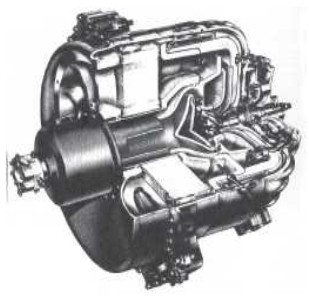
“Garrett-Ford AGT.101”
-For the Boeing 777, the on-board APU is the Garrett GTCP-331-500B, based on the "core" of the TPE-331 turboprop.
-The auxiliary energy products are made at the GAPD or Garrett Auxiliary Power Division.
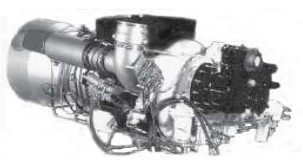
“APU, GTCP-331-500B model”
-From Allied Signal, the JFS-100 in normal and afterburning versions.

“Garrett-Allied Signal JFS-100”

“JFS-100 (HTF-100), 150 lbs”

“JFS-100”
-The JFS-100 gives 95 hp as a turboshaft and in the case of modification for a pure turbojet it delivers 100 lbf. of thrust.
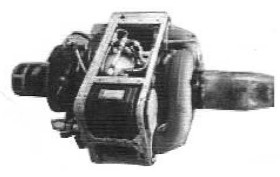
“Garrett GTP-60”

“Allied Signal-Garrett GTP-60 in its container”

“Two Garrett engines between the 50’s and 80’s”

“The GTP-70 was the APU for the KC-135 aircraft”

“Garrett GTP30-150, APU, 150 hp”

“Garrett GTCP-36 at the Munich Museum”
From Appendix A1/6: Currently it is Honeywell. Shortly before this change it was Allied Signal and AiResearch.
-The small turbine engine known as JFS-100 in its various versions (-13, -13A, -24, etc.) is being used for light aviation, after adaptation.
-Some of them as interesting as Scott Ehni's (see).
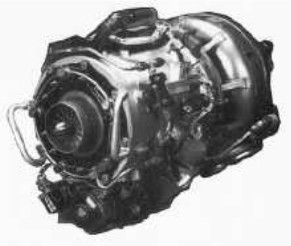
“Garrett JFS-100”
-It works as a "Jet Fuel Starter" (JFS) that gives total autonomy. It is supplied with the same fuel that is in the airplane tanks, kerosene.
-An electric starter starts the JFS-100 and this in turn gets the main engine in motion in its start-up process.
-This in contrast to air-starters, which also are produced by Garrett. See the main text for an example.
-JFS starters have been installed on combat aircraft such as the Crusader A-7 and the Douglas A4D.
-In the below illustration we can see a cross-section of the engine.
-It has a centrifugal compressor and a centripetal turbine, ensembled together forming a unit. There is an inverted-flow, annular combustion chamber. More bulky is the set of accessory box, gear, and oil tank. It has bases for an electric starter and a tachometer.
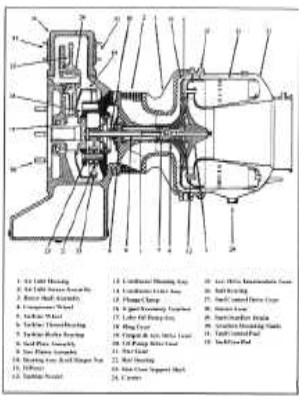
"Outline and description of the elements"
-This engine is considered a derivative of the ATS-100.
-In the LFC (Laminar Flow Control) programs or LFS (System), an AiResearch-Garrett engine was used to create suction through the nacelle inside the wing and through slots on top of it.
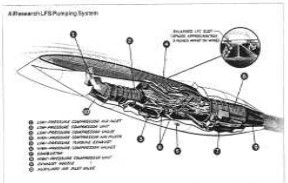
"Using an AiResearch-Garrett in the LFS"
-Curious photograph of the Garrett (AiResearch) Model 85 starter. Used in engines such as Pratt & Whitney to launch the J-75 and J-57 to start.
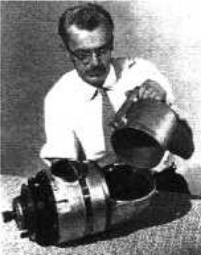
“Model 85”
-It is difficult to identify this form with the one that appears in the main text. It could work with fuel cartridges like the USAF'S MXU.4/A composed of ammonia-nitrate, igniting electrically producing a lot of gases and make this engine rotate at 75,000 rpm giving 100 hp and starting the main engine in 20 sec.
-It could also be fed only with compressed air from an external auxiliary turbine or from another operating engine on the same aircraft.
-AirResearch (then Garrett, then Allied Signal, then Honeywell) has seen its JFS100 turbine starters applied to a minor aviation group as main engines.
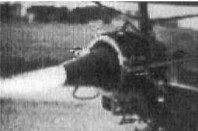
“Garrett JFS100-13, running”
-We have a JFS100-13 mounted on a wing-type ULM, Mitchell Wing B-10, in the picture below.

“Flying Wing with JFS-100”
-It is indicated that in Oklahoma a modified JFS-100 was installed to take advantage of the gas energy for a second turbine and propeller (in short a turboprop), obtaining better performance in ascent and cruising. Information from Steve Trentman.
From Appendix 9: Below we show the picture of a Garrett JFS-100 turbine starter adaption for use in UAVs, drones, ULM, etc. Lately this engine is chosen for these purposes.
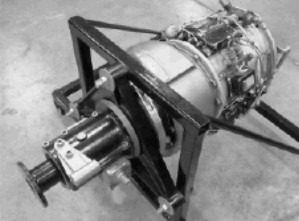
“JFS-100 with PTO for the propeller”
Engines of GARRETT
Model: AGT-101 (Ford)
Arquitecture:
Compressor/s:
Combustion chambers:
Turbines:
Power / Thrust:
Weight:

"Garrett-Ford AGT.101"
Model: APP y APU series
Model: Arrancadores como el JFS-10
Model: ATF-3 (F-104)
Arquitecture: Turbofan
Compressor/s: Single Stage LP Fan, 5 stage IP axial compressor and single stage HP centrifugal compressor
Combustion chambers: Reverse flow annular combustion chamber
Turbines: Single stage HP, 3-stage IP, 2-stage LP
Power / Thrust: --- / 5440 Lbf
Weight:

"Garret ATF-3"
Model: CFE-738 (GE)
Arquitecture: Turbofan
Compressor/s:
Combustion chambers:
Turbines:
Power / Thrust: --- / 5918 Lbf
Weight:

"Garret CFE-738"
Model: ETJ-131
Arquitecture:
Compressor/s: One centrifugal compressor
Combustion chambers: Inverted tubular combustion chamber
Turbines: one centripetal turbine
Power / Thrust: --- / 100 Lbf
Weight:
Expendable turbojet (ETJ). Thrust increasing to 200 lbf by a simple form of afterburning.
Model: F-104
Arquitecture:
Compressor/s:
Combustion chambers:
Turbines:
Power / Thrust: / ---
Weight:
Model: F-109 (TFE-76)
Arquitecture: Turbofan
Compressor/s:
Combustion chambers:
Turbines:
Power / Thrust: --- / 1500 Lbf
Weight:

"Garret F-109"
Model: F-124 (TFE-1042 y TFE-1088)
Arquitecture: Turbofan
Compressor/s:
Combustion chambers:
Turbines:
Power / Thrust:
Weight:
Thrust: 3,630 lbf. for the -5, progressively increasing to 4,150 lbf. dry and 6,800 lbf. with afterburning for the -7.
Model: F-125
Arquitecture: Turbofan
Compressor/s:
Combustion chambers:
Turbines:
Power / Thrust:
Weight:
The F125 is an afterburning version of the F124 engine.
Model: IE990
Arquitecture:
Compressor/s:
Combustion chambers:
Turbines:
Power / Thrust: / ---
Weight:

"Garret IE990"
Model: JFS-100
Arquitecture:
Compressor/s:
Combustion chambers:
Turbines:
Power / Thrust: / ---
Weight:

"Garret JFS-100"
Model: T-76
Arquitecture:
Compressor/s:
Combustion chambers:
Turbines:
Power / Thrust: / ---
Weight:

"Garrett TFE-76-1075-4"
Model: T-800
Arquitecture:
Compressor/s:
Combustion chambers:
Turbines:
Power / Thrust: / ---
Weight:

"Garrett T-800 cutaway"
Model: TFE-1042 (Volvo)
Arquitecture:
Compressor/s:
Combustion chambers:
Turbines:
Power / Thrust: / ---
Weight:

"Garret TFE-1042"
Model: TFE-1088
Arquitecture:
Compressor/s:
Combustion chambers:
Turbines:
Power / Thrust: / ---
Weight:
Model: TFE-124
Arquitecture:
Compressor/s:
Combustion chambers:
Turbines:
Power / Thrust: / ---
Weight:

"Garret TFE-124"
Model: TFE-531
Arquitecture: Turbofan
Compressor/s:
Combustion chambers:
Turbines:
Power / Thrust:
Weight:

"Garret TFE-531"
Model: TFE-731
Arquitecture: Turbofan
Compressor/s:
Combustion chambers:
Turbines:
Power / Thrust: --- / 3500 Lbf
Weight:
The TFE-731-5A engine has a silent exhaust system consisting of a rosette that divides the flow, passing it to other higher, not-audible frequencies.

"Garrett T-731"
Model: TPE-331 (T76)
Arquitecture: Turboprop
Compressor/s: 2 centrifugal compressors
Combustion chambers: Annular combustion chamber
Turbines: Three-stage turbine
Power / Thrust: 1400SHP / Lbf
Weight:

"Garret TPE-331, lower air-intake version"
Model: TPF-331
Arquitecture:
Compressor/s:
Combustion chambers:
Turbines:
Power / Thrust: / ---
Weight:
Model: TPF-351
Arquitecture:
Compressor/s:
Combustion chambers:
Turbines:
Power / Thrust: / ---
Weight:

"garret TPF-351"
Model: TSE-331
Arquitecture:
Compressor/s:
Combustion chambers:
Turbines:
Power / Thrust: / ---
Weight:


